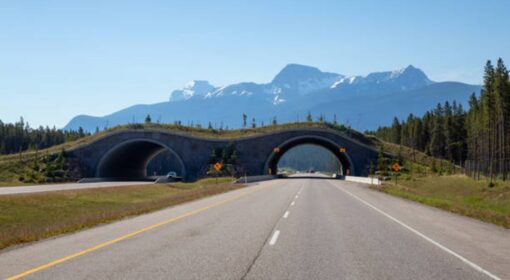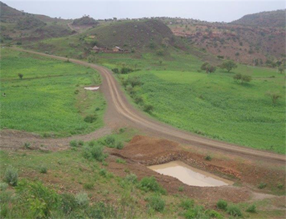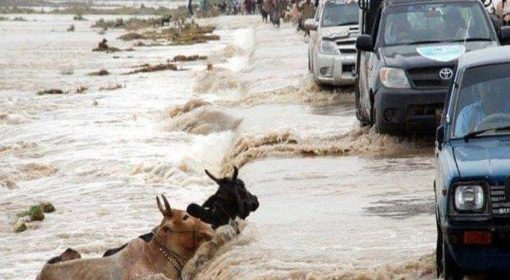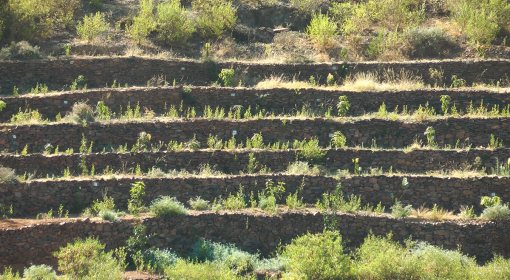posted by Kifle Woldearegay and Frank van Steenbergen
October 02, 2014
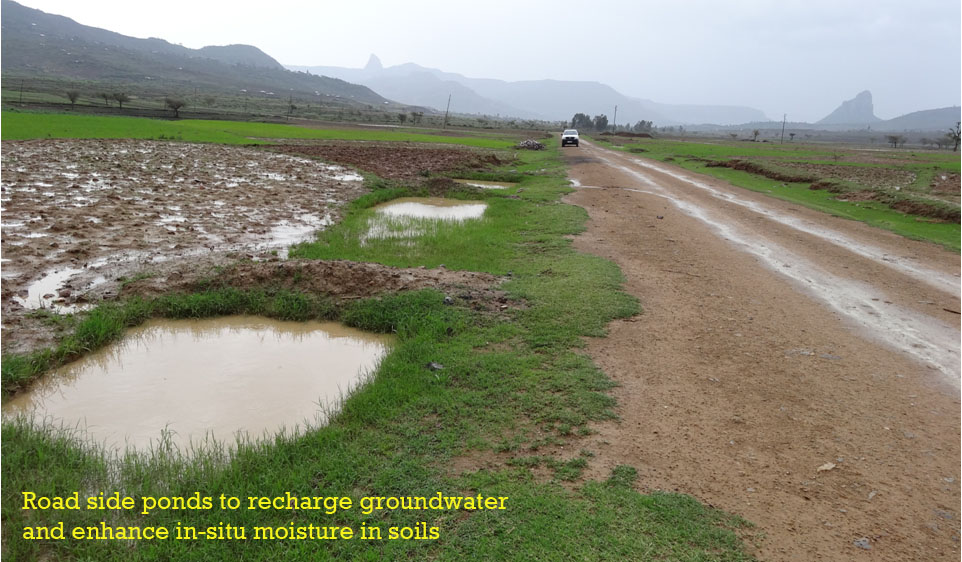
With an estimated USD 7 billion a year being spent on road construction in Sub-Saharan Africa alone, and the same roads massively interfering with rain run-off, connecting the dots between road development and waterbuffering is a no-brainer. Rather than having roads damaged by water, and water from roads flooding land and severely eroding landscapes, using the roads for water harvesting and groundwater recharge is an obvious winner. It is surprising that so little has been done so far.
There is much to gain from connecting the ‘roads’ and ‘water’ worlds. For ‘roads’ people one major headache is the compensation claims by local communities for gully damage. These gullies often develop immediately downstream of culverts once the road is commissioned, deplete soil moisture and rut the land. On the other hand, water-related damage to roads is also significant: estimated to account for 35% of all maintenance costs.
Connecting roads, water and livelihoods was the idea behind a 15-month pilot research program in Ethiopia that examined how to optimize road development for groundwater recharge and retention. The program was supported by the NERC and ESRC (UK) under a joint program called ‘UPGRO’ – or Unlocking the Potential of Groundwater for Poverty Reduction in Africa. Under the program, the scope for recharging groundwater from roads in Ethiopia’s Tigray region was investigated and discussed.
If there ever was a research program that translated into action, this may well have been the one.
The first activityof the program (implemented by Mekelle University, MetaMeta, Institute of Development Studies (UK), Tigray Bureau of Agriculture and Rural Development, Tigray Bureau of Transport and Roads) was to hook up roads and water people and the local government. They had never been talking. Yet the research established that they faced a big common issue. Reconnaissance along a 200-km stretch revealed that:
- road construction had given rise to gully erosion in 150 culvert locations;
- flooding of farm lands and dwelling houses was recorded in 45 locations,
- water logging was observed in 65 locations.
Social science research was undertaken to understand how this mismatch happened and to understand local perceptions. Apart from understanding the shortcomings of the road building process (lack of interaction, no attention for downstream effects of water, rigid budget systems), it also gave a human face to the challenge and helped mobilize communities to partner in the discussion around water-sensitive road development.
The second achievement was to work on solutions. Technically, there is much scope to do a lot better in road construction in a semi-arid hilly areas such as Tigray. Moreover, the solutions are usually not too complicated or costly. The repertoire consists of:
(1) carefully planning road alignments, controlling the speed of surface run-off as well at the routing of run-off towards specific infiltration/recharge areas;
(2) develop erosion control around roads minimize gullying and moisture depletion from concentrated run-off
(3) using road surface in conjunction with rolling dips and side drains to collect run-off and bring to recharge areas
(4) planning cross drainage to impede and direct run-off to recharge zones and on the downstream side of the road to prevent gullying;
(5) re-designing road foundation/compaction so they do not hinder groundwater base-flow to shallow wells;
(6) considering the use of the concentrated runoff from the road surfaces to recharge and retention areas and structures such as small recharge ponds;
(6) carefully constructing road crossings through low causeways or Irish bridges in dry river beds so that they retain groundwater upstream of the road, thus crossing and increasing bank infiltration and serving as proxy sand dams
(7) using flood water spreading weirs and bed stablilizers for river crossing – making use of these structures to spread floods widely, reduce erosion and increase groundwater tables
(8) systematically using borrow pits as recharge or excavation ponds
(9) spring capture where roads are made in deep cut
(10) making use of excavation material (or borrow material from other sources) to improve soil quality.
The involvement of the two professional communities; the pressure of roadside communities; the generally strong, positive role of government; and the many doable solutions came together and things clicked magically in Tigray. The uptake of the research recommendations was phenomenal. From February to August 2014, the Tigray region implemented (at its own cost) a number of mechanisms of harvesting water from roads in 30 district (woredas) of the region as part of soil moisture conservation programs. The program was led by the regional government under its soil moisture improvement program but implemented by local communities. Here are some of the most popular technologies:
- use of road borrow pits for water harvesting,
- diverting water from road culverts into specially developed percolation ponds,
- direct road-side water diversion to farmlands,
- construction of infiltration pits along road sides,
- diverting water from culverts and bridges into deep trenches, check-dams, and other groundwater recharge mechanisms, and
- construction of series of percolation systems at upstream sides of roads in order to reduce flooding and enhance groundwater recharge.
- (For images see slideshow below)
There are, in fact, many more options to make use of water from roads but they would need to be built into the road construction process from the very beginning. A good example is the use of ford river crossing as sand dams or aligning roads to channel runoff towards recharge zones.
Monitoring of these pilots is ongoing, with the first rainy ‘test’ season just about to end. Initial results are promising. Moisture levels in soil along the roads have improved and shallow groundwater levels have increased. Moreover, gully expansion has been halted.
This has created something like a ‘success breeds success’ effect. Tigray had earlier taken the lead in intensive watershed management in Ethiopia; and is now taking the lead in developing roads for improving water development as well. Momentum is building for integrating road construction, water harvesting and environmental management and make it part of the next five-year plan for the region.
The potential for upscaling of “water harvesting from roads”to the Tigray, Ethiopia and even beyond is very high. The potential for uptake by local communities and decision makers is high because:
(a) the negative effects of roads are turned into positives,
(b) the problem of water scarcity in the arid/ semi-arid regions of Ethiopia is being addressed at low additional costs,
(c) demand for water is increasing because of the ongoing irrigation developments, and
(d) there is greater awareness on the importance of water across the society—from community members to decision makers at all levels.
